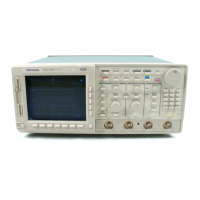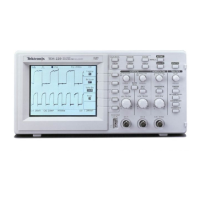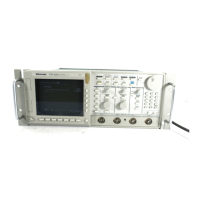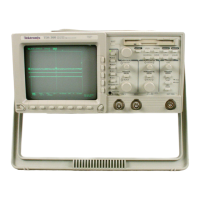Saving Waveforms and Setups
TDS 500D, TDS 600B, & TDS 700D User Manual
3–175
To rearm the oscilloscope for taking a new autosave single acquisition sequence,
press RUN/STOP.
To avoid loss of reference waveforms, you can save them to disk (use the
SAVE/RECALL WAVEFORM menu), before rearming the oscilloscope.
Consider the following operating characteristics when using autosave.
Autosave saves all “live” waveforms; that is, waveforms displayed in CH 1 –
CH 4. To be saved, the live waveforms must be displayed on screen.
Autosave saves each live waveform into the reference memory that
corresponds to the channel (CH 1 to Ref1, CH 2 to Ref2, and so on).
Autosave, when executing, erases all four reference memories. To avoid loss
of important waveforms, you may want to save them to a disk file before
enabling a single acquisition sequence.
Autosave is not available in DPO mode or if Extended Acquisition is On.
To run file utilities, see the Managing the File System on page 3–175.
Managing the File System
The TDS Oscilloscope provides file utilities and a floppy disk drive (and
optional hard disk) for saving hardcopies, setups, and waveforms. This section
describes how to manage (delete, rename, etc.) these files using the file system.
Read the sections listed under To Find More Information on page 3–180 for
information on saving hardcopies, setups, and waveforms.
The File Utilities menu lets you delete, rename, copy, print files, create a new
directory, operate the confirm delete and overwrite lock, and format disks.
To bring up the File Utilities menu:
1. TDS 600B: Press the SAVE/RECALL SETUP button to bring up the
Save/Recall Setup menu, or press SAVE/RECALL WAVEFORM (pop-up)
to bring up the Save/Recall Waveform menu, or press the SHIFT HARD-
COPY button to bring up the Hardcopy menu.
To Run the File Utilities
To Access the File Utilities

